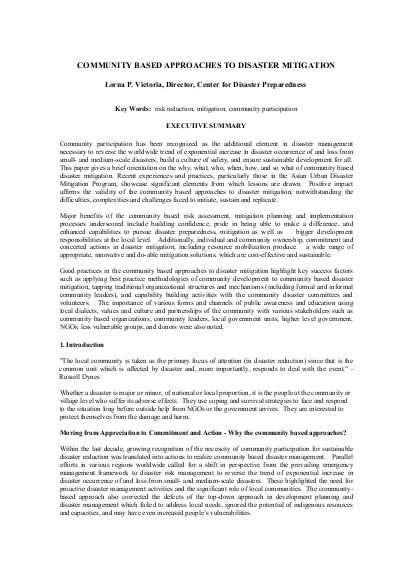
Community participation has been recognized as the additional element in disaster management necessary to reverse the worldwide trend of exponential increase in disaster occurrence of and loss from small- and medium-scale disasters, build a culture of safety, and ensure sustainable development for all. This paper gives a brief orientation on the why, what, who, when, how, and so what of community based disaster mitigation. Recent experiences and practices, particularly those in the Asian Urban Disaster Mitigation Program, showcase significant elements from which lessons are drawn. Positive impact affirms the validity of the community based approaches to disaster mitigation, notwithstanding the difficulties, complexities and challenges faced to initiate, sustain and replicate. Major benefits of the community based risk assessment, mitigation planning and implementation processes underscored include building confidence, pride in being able to make a difference, and enhanced capabilities to pursue disaster preparedness, mitigation as well as bigger development responsibilities at the local level. Additionally, individual and community ownership, commitment and concerted actions in disaster mitigation, including resource mobilization produce a wide range of appropriate, innovative and do-able mitigation solutions, which are cost-effective and sustainable. Good practices in the community based approaches to disaster mitigation highlight key success factors such as applying best practice methodologies of community development to community based disaster mitigation, tapping traditional organizational structures and mechanisms (including formal and informal community leaders), and capability building activities with the community disaster committees and volunteers. The importance of various forms and channels of public awareness and education using local dialects, values and culture and partnerships of the community with various stakeholders such as community based organizations, community leaders, local government units, higher level government, NGOs, less vulnerable groups, and donors were also noted.
Resource collections
- UN Habitat - Urban Response Collection
- Urban Response - Urban Crisis Preparedness and Risk Reduction
- Urban Response Collection - Community Engagement and Social Cohesion
- Urban Response Collection - Economic Recovery
- Urban Response Collection - Environment and Climate Change
- Urban Response Collection - Housing, Land and Property
- Urban Response Collection - Urban Crisis Response, Recovery and Reconstruction
- Urban Response Collection - Urban Resilience